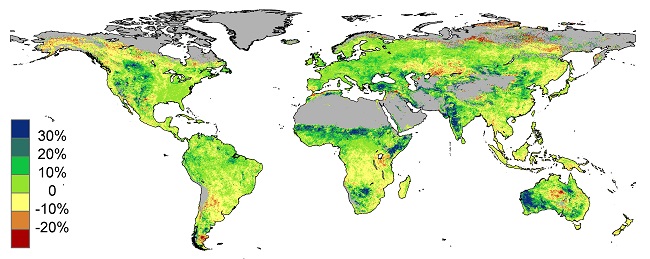This article is more than 1 year old
Rising CO2 is turning the world's deserts green
Arid regions blossom as humanity's beneficial burning takes effect
Opinion Far from turning the Earth into a baking lifeless hell as had been thought, elevated levels of atmospheric CO2 are causing the deserts of the world to bloom with new green foliage.

Fire up the patio heater and watch the world turn green!
That's according to new research from government scientists in Australia, who've been scanning the planet's formerly dry and lifeless regions using satellite imagery.
"We found a strong link between the rise in atmospheric CO2 concentrations and a greening that’s been observed across many of the world’s arid environments," explains Dr Randall Donohue of the Commonwealth Scientific and Industrial Research Organisation (CSIRO), Australia's national science agency.
According to Donohue and his colleagues' research, climbing levels of CO2 in the air correlated with an 11 per cent increase in foliage cover from 1982 to 2010 across arid areas in Australia, North America, the Middle East and Africa.
"In Australia, our native vegetation is superbly adapted to surviving in arid environments and it consequently uses water very efficiently," Dr Donohue says.
"This, along with the vast extents of arid landscapes, means Australia featured prominently in our results."
Scientists had long speculated that rising carbon levels would make life easier for the green plants which keep us all alive by the sun-powered process of photosynthesis, in which they suck CO2 from the air, mix it with water to make sugar for themselves and throw away some of the oxygen (so permitting us animals to breathe).
"Our work was able to tease-out the CO2 fertilisation effect," explains Donohue, saying he and his team adjusted their satellite data to account for other processes such as precipitation, air temperature, the amount of light, and land-use changes.
Donohue cautions that the greening of the deserts could have unforeseen side-effects - for instance there might be more wildfires, now that there are more leaves and plants in arid regions to dry out and burn during hot seasons. Certainly there has been much media coverage of wildfires in recent years.
Nonetheless, he says, "on the face of it, elevated CO2 boosting the foliage in dry country is good news".
That would certainly seem to be true for those worried about a warming world. A powerful negative feedback of this sort would suggest that worries over positive-feedback runaway warming - of the sort which underlies the more negative climate forecasts - is much less likely than had been thought.
Donohue and his colleagues' research has been published in the journal Geophysical Research Letters, and was flagged up by CSIRO here. ®
